Exposure to Wind as a Threat to the Sustainable Development of Small Towns in the Zhambyl Region (Kazakhstan)
Abstract
:1. Introduction
1.1. Sustainable Cities and Towns
1.2. Threats to the Sustainable Development of Cities and Towns
1.3. Kazakhstan Towns and the Aim of Study
2. Materials and Methods
2.1. Research Area
2.2. Data Collection Methods, Concept, and Stages of Research
- The statistics associated with adverse natural phenomena and accidents in the study area were studied using the resources of the Department of Emergency Situations of the Zhambyl Region.
- Analysis of materials collected during field research was performed.
- (1)
- Preliminary field research in the Zhambyl region;
- (2)
- Analysis and assessment of the possibility of using existing research results, based on the collected literature, on the selected topic of the studied cities, and related to determining the sustainable development of urban areas;
- (3)
- Defining the theoretical framework for researching the threats associated with the development of sustainable monocities;
- (4)
- Conducting further field research aimed at the examination of wind conditions and the effects of strong winds on the inhabitants and infrastructure of the studied cities, using quantitative and statistical methods;
- (5)
- Assessment of state policies aimed at supporting the sustainable development of cities in Kazakhstan, based on research and analysis of the literature;
- (6)
- Verification of the research hypothesis.
3. Results
3.1. Climatic Conditions
3.2. Climate Change and Adverse Natural Phenomena
3.3. State Policy to Support the Sustainable Development of Kazakhstan’s Cities
4. Discussion
5. Conclusions
- Altered anthropogenic landforms (landfills in an arid continental climate are not overgrown with vegetation; therefore, due to prevailing winds, they are sources of toxic dust);
- The locations of the industrial zones of the cities of Zhanatas and Karatau having been determined without taking into account the prevailing wind directions (winds blowing from the industrial zone to the city pollute the air);
- Sprawl of the territories of cities (the territories of cities are heterogeneously populated, and areas with uninhabitable houses remain; all of this does not contribute to the effective use of urban networks and impedes communications in the event of natural disasters);
- Lack of alternative life-support systems for cities during natural disasters. In this regard, in small towns of the Zhambyl region, it is proposed to introduce decentralized and autonomous heating systems for multi-apartment residential buildings, since these cities are provided with main gas pipelines.
Author Contributions
Funding
Institutional Review Board Statement
Informed Consent Statement
Data Availability Statement
Conflicts of Interest
References
- United Nations. Transforming our world: The 2030 agenda for sustainable development. In Resolution Adopted by the General Assembly on 25 September 2015, RES/70/1; United Nations: New York, NY, USA, 2015. [Google Scholar]
- ICLEI—Local Governments for Sustainability. The ICLEI Montréal Commitment and Strategic Vision 2018–2024; ICLEI: Bonn, Germany, 2018. [Google Scholar]
- Tanguay, G.A.; Rajaonson, J.; Lefebvre, J.-F.; Lanoie, P. Measuring the sustainability of cities: An analysis of the use of local indicators. Ecol. Indic. 2010, 10, 407–418. [Google Scholar] [CrossRef]
- Koichiro, M.; Christodoulou, A. Review of sustainability indices and indicators: Towards a new City Sustainability Index (CSI). Environ. Impact Assess. Rev. 2012, 32, 94–106. [Google Scholar] [CrossRef]
- ISO 37120:2018; Cities, Sustainable, Communities—Indicators for City Services and Quality of Life. ISO: Geneva, Switzerland, 2018.
- Haughton, G.; Hunter, C. Sustainable Cities; Jessica Kingsley Publishers Ltd.: London, UK, 1994. [Google Scholar]
- Nijkamp, P.; Perrels, A. Sustainable Cities in Europe; Routledge: New York, NY, USA, 2014. [Google Scholar]
- Caprotti, F.; Yu, L. Sustainable Cities in Asia, 1st ed.; Taylor and Francis: New York, NY, USA, 2017; Available online: https://www.perlego.com/book/1513256/sustainable-cities-in-asia-pdf (accessed on 25 September 2023).
- Bithas, K.P.; Christofakis, M. Environmentally sustainable cities: Critical review and operational conditions. Sustain. Dev. 2006, 14, 177–189. [Google Scholar] [CrossRef]
- Yigitcanclar, T.; Kamruzzaman, M. Planning, development and management of sustainable cities. A commentary from the guest editors. Sustainability 2015, 7, 14677–14688. [Google Scholar] [CrossRef]
- Davidson, K.M.; Kellett, J.; Wilson, L.; Pullen, S. Assessing urban sustainability from a social democratic perspective: A thematic approach. Local Environ. 2012, 17, 57–73. [Google Scholar] [CrossRef]
- Ding, X.; Zhong, W.; Shearmur, R.G.; Zhang, X.; Huisingh, D. An inclusive model for assessing the sustainability of cities in developing countries—Trinity of cities’ sustainability from spatial, logical and time dimensions (TCS-SLTD). J. Clean. Prod. 2015, 109, 62–75. [Google Scholar] [CrossRef]
- Michalina, D.; Mederly, P.; Diefenbacher, H.; Held, B. Sustainable Urban Development: A Review of Urban Sustainability Indicator Frameworks. Sustainability 2021, 13, 9348. [Google Scholar] [CrossRef]
- Niemets, K.; Kravchenko, K.; Kandyba, Y.; Kobylin, P.; Morar, C. World cities in terms of the sustainable development concept. Geogr. Sustain. 2021, 2, 304–311. [Google Scholar] [CrossRef]
- Folke, C. Resilience: The emergence of a perspective for social–ecological systems analyses. Glob. Environ. Change 2006, 16, 253–267. [Google Scholar] [CrossRef]
- Ostrom, E. A General Framework for Analyzing Sustainability of Social-Ecological Systems. Science 2009, 325, 419–422. [Google Scholar] [CrossRef]
- Partelow, S. A review of the social-ecological systems framework: Applications, methods, modifications, and challenges. Ecol. Soc. 2018, 23, 36. [Google Scholar] [CrossRef]
- Pereira, L.M.; Karpouzoglou, T.; Frantzeskaki, N.; Olsson, P. Designing Transformative Spaces for Sustainability in Social-Ecological Systems. Ecol. Soc. 2018, 23, 32. [Google Scholar] [CrossRef]
- Fuller, J.L.; van Putten, I.; Kraan, M.; Bjørkan, M.; Dankel, D.J. Sustainability is not a vegan coffee shop. Eliciting citizen attitudes and perspectives to localize the UN sustainable development goals. J. Environ. Plan. Manag. 2023, 67, 1–22. [Google Scholar] [CrossRef]
- Nováček, P.; Mederly, P. How to Measure Progress Towards Quality and Sustainability of Life? Ekológia 2015, 34, 7–18. [Google Scholar] [CrossRef]
- Spangenberg, J.H. Indicators for sustainable development. In Routledge International Handbook of Sustainable Development; Redclift, M., Springett, D., Eds.; Routledge: London, UK, 2015; Routledge Handbooks Online; Available online: https://www.routledgehandbooks.com/doi/10.4324/9780203785300.ch20 (accessed on 13 August 2023).
- Assmann, D.; Honold, J.; Grabow, B.; Roose, J. SDG-Indikatoren für Kommunen: Indikatoren zur Abbildung der Sustainable Development Goals der Vereinten Nationen in deutschen Kommunen; Bertelsmann Stiftung, Bundesinstitut für Bau-, Stadt- und Raumforschung, Deutscher Landkreistag, Deutscher Städtetag, Deutscher Städte- und Gemeindebund, Deutsches Institut für Urbanistik, Engagement Global: Gütersloh, Germany, 2018. [Google Scholar]
- The Leipzig Charter. The Transformative Power of Cities for the Common Good. Adopted at the Informal Ministerial Meeting on Urban Matters on 30 November 2020. Available online: https://ec.europa.eu/regional_policy/sources/brochure/new_leipzig_charter/new_leipzig_charter_en.pdf (accessed on 23 August 2023).
- Tan, J.; Zhang, P.; Lo, K.; Li, J.; Liu, S. Conceptualizing and measuring economic resilience of resource-based cities: Case study of Northeast China. Chin. Geogr. Sci. 2017, 27, 471–481. [Google Scholar] [CrossRef]
- Wendt, J.A.; Bogdał-Brzezińska, A. Security and Securitization as Topics in Sustainability and Tourism Research. Sustainability 2024, 16, 905. [Google Scholar] [CrossRef]
- Taureck, R. Securitization theory and securitization studies. J. Int. Relat. Dev. 2006, 9, 53–61. [Google Scholar] [CrossRef]
- Balzacq, T. The ‘Essence’ of securitization: Theory, ideal type, and a sociological science of security. Int. Relat. 2015, 29, 103–113. [Google Scholar] [CrossRef]
- Rakhmetova, R.; Zhakenova, K.; Abenova, K.; Ryskulova, M.; Andekina, R. Classification and assessment of cities in Kazakhstan in terms of their development potential. Rev. Espac. 2017, 38, 1–13. [Google Scholar]
- Turgel, I.; Bozhko, L.; Leskova, L. State Support of Monotowns in Russia and Kazakhstan: Experience and Problems. Energy Procedia 2016, 95, 5590563. [Google Scholar] [CrossRef]
- Junussova, M.; Beimisheva, A. Monotowns of Kazakhstan: Development Challenges and Opportunities. In Kazakhstan’s Developmental Journey; Koulouri, A., Mouraviev, N., Eds.; Palgrave Macmillan: Singapore, 2021; pp. 211–247. [Google Scholar] [CrossRef]
- UNDP in Kazakhstan. Urbanization as an Accelerator of Inclusive and Sustainable Development. In National Human Development Report 2019; UNDP in Kazakhstan: Nur-Sultan, Kazakhstan, 2019. [Google Scholar]
- Rohner, T. The second life of the Monotown: Questioning narratives of failed Soviet urban modernity in contemporary Kazakhstan. In Beyond Post-Soviet: Layered Legacies and Transformations in Central Asia; Schmidt, M., Ed.; Universität Augsburg: Augsbur, Germany, 2019; pp. 64–74. [Google Scholar]
- UNECE. Smart Sustainable Cities Profile Nur-Sultan, Kazakhstan; United Nations Publication, Economic Commission for Europe (UNECE): Geneve, Switzerland, 2020. Available online: https://unece.org/sites/default/files/2021-01/Nur-Sultan%20City%20Profile_compressed_E.pdf (accessed on 15 November 2023).
- Toxanov, S.; Neftissov, A.; Abzhanova, D.; Kazambayev, I. The Concept of The Smart City of Astana: Energy-Efficient Technologies and Solutions for Sustainable Development. Sci. J. Astana IT Univ. 2022, 11, 74–86. [Google Scholar] [CrossRef]
- Alibekova, G.; Panzabekova, A.; Satpayeva, Z.; Abilkayir, N. Sustainable development issues of Almaty as the largest metropolis in Central Asia. IOP Conf. Ser. Earth Environ. Sci. 2018, 177, 012010. [Google Scholar] [CrossRef]
- Mendybayev, B. Imbalances in Kazakhstan’s Smart Cities Development. Environ. Urban. ASIA 2022, 13, 144–152. [Google Scholar] [CrossRef]
- Lopes, A.; Oliveira, S.; Fragoso, M.; Andrade, J.; Pedro, P. Wind Risk Assessment in Urban Environments: The Case of Falling Trees During Windstorm Events in Lisbon. In Bioclimatology and Natural Hazards; Střelcová, K., Mátyás, C., Kleidon, A., Lapin, M., Matejka, F., Blaženec, M., Škvarenina, J., Holécy, J., Eds.; Springer: Dordrecht, The Netherlands, 2009; pp. 55–74. [Google Scholar] [CrossRef]
- He, Y.; Wu, B.; He, P.; Gu, W.; Liu, B. Wind disasters adaptation in cities in a changing climate: A systematic review. PLoS ONE 2021, 16, e0248503. [Google Scholar] [CrossRef]
- Martínez Méndez, A.; Frausto Martínez, O.; Castillo Villanueva, L.; Camacho Sanabria, J. Index of potable water infrastructure resilence facing hurricanes in coastal cities. Rev. Geográfica América Cent. 2018, 3, 339–365. [Google Scholar] [CrossRef]
- Priestley, M.D.K.; Catto, J.L. Future increased risk from extratropical windstorms in northern Europe. Nat. Commun. 2023, 14, 4434. [Google Scholar] [CrossRef]
- Frausto, O.; Vazquez, A.; Arroyo, L.; Castillo, L.; Hernández, M.L. Hurricane resilience indicators in Mexican Caribbean coastal cities. Int. J. SAFE 2016, 6, 755–763. [Google Scholar] [CrossRef]
- Anenberg, S.C.; Achakulwisut, P.; Brauer, M.; Moran, D.; Apte, J.S.; Henze, D.K. Particulate matter-attributable mortality and relationships with carbon dioxide in 250 urban areas worldwide. Sci. Rep. 2019, 9, 11552. [Google Scholar] [CrossRef]
- Lelieveld, J.; Evans, J.; Fnais, M.; Giannadaki, D.; Pozzer, A. The contribution of outdoor air pollution sources to premature mortality on a global scale. Nature 2015, 525, 367–371. [Google Scholar] [CrossRef] [PubMed]
- Marlier, M.E.; Jina, A.S.; Kinney, P.L.; DeFries, R.S. Extreme Air Pollution in Global Megacities. Curr. Clim. Change Rep. 2016, 2, 15–27. [Google Scholar] [CrossRef]
- Adelekan, I.O. Vulnerability to wind hazards in the traditional city of Ibadan, Nigeria. Environ. Urban. 2012, 24, 597–617. [Google Scholar] [CrossRef]
- Bhanarkar, A.D.; Purohit, P.; Rafaj, P.; Amann, M.; Bertok, I.; Cofala, J.; Rao, P.S.; Vardhan, B.H.; Kiesewetter, G.; Sander, R.; et al. Managing future air quality in megacities: Co-benefit assessment for Delhi. Atmos. Environ. 2018, 186, 158–177. [Google Scholar] [CrossRef]
- Al-Obaidi, I.; Rayburg, S.; Półrolnicza, M.; Neave, M. Assessing the Impact of Wind Conditions on Urban Heat Islands in Large Australian Cities. J. Ecol. Eng. 2021, 22, 1–15. [Google Scholar] [CrossRef]
- Li, J.; Ma, X.; Zhang, C. Predicting the spatiotemporal variation in soil wind erosion across Central Asia in response to climate change in the 21st century. Sci. Total Environ. 2020, 709, 136060. [Google Scholar] [CrossRef]
- Issanova, G.; Kaldybayev, A.; Ge, Y.; Abuduwaili, J.; Ma, L. Spatial and Temporal Characteristics of Dust Storms and Aeolian Processes in the Southern Balkash Deserts in Kazakhstan, Central Asia. Land 2023, 12, 668. [Google Scholar] [CrossRef]
- O’Hara, S.L.; Wiggs, G.F.; Mamedov, B.; Davidson, G.; Hubbard, R.B. Exposure to airborne dust contaminated with pesticide in the Aral Sea region. Lancet 2000, 355, 627–628. [Google Scholar] [CrossRef]
- Ge, Y.; Abuduwaili, J.; Ma, L.; Wu, N.; Liu, D. Potential transport pathways of dust emanating from the playa of Ebinur Lake, Xinjiang, in arid northwest China. Atmos. Res. 2016, 178–179, 196–206. [Google Scholar] [CrossRef]
- Issanova, G.; Abuduwaili, J.; Kaldybayev, A.; Semenov, O.; Dedova, T. Dust storms in Kazakhstan: Frequency and division. J. Geol. Soc. India 2015, 85, 348–358. [Google Scholar] [CrossRef]
- Nobakht, M.; Shahgedanova, M.; White, K. New inventory of dust emission sources in Central Asia and northwestern China derived from MODIS imagery using dust enhancement technique. J. Geophys. Res. Atmos. 2021, 126, 234072974. [Google Scholar] [CrossRef]
- Tong, D.; Li, J.; Zhao, Y.; Ta, L. The Impact of the Industrial Restructuring on the Environment in the Resource-Based City: A Case Study of Daqing. In Proceedings of the 2014 1st International Conference on Industrial Economics and Industrial Security, Beijing, China, 23–26 July 2014; Li, M., Zhang, Q., Zhang, R., Shi, X., Eds.; Springer: Berlin/Heidelberg, Germany, 2015; pp. 431–436. [Google Scholar] [CrossRef]
- Pourasl, H.H.; Khojastehnezhad, V.M. Techno-economic analysis of wind energy potential in Kazakhstan. Proc. Inst. Mech. Eng. Part A J. Power Energy 2021, 235, 1563–1576. [Google Scholar] [CrossRef]
- Jianzhong, X.; Assenova, A.; Erokhin, V. Renewable Energy and Sustainable Development in a Resource-Abundant Country: Challenges of Wind Power Generation in Kazakhstan. Sustainability 2018, 10, 3315. [Google Scholar] [CrossRef]
- Meteorological Database. Available online: https://meteo.kazhydromet.kz/database_meteo/ (accessed on 22 April 2023).
- Ameen, R.M.; Mourshed, M.; Li, H. A critical reviewof environmental assessment tools for sustainable urban design. Environ. Impact Assess. Rev. 2015, 55, 110–125. [Google Scholar] [CrossRef]
- Wind Chill Index. Available online: https://www.canada.ca/en/environment-climate-change/services/weather-health/wind-chill-cold-weather/wind-chill-index.html#toc8 (accessed on 15 September 2023).
- Meteoblue.com. Available online: https://www.meteoblue.com/ (accessed on 22 April 2023).
- Za-10-Dney-Vypolneny-Masshtabnye-Raboty-Po-Vosstanovleniyu-Elektrosetey-V-Postradavshih-Ot-Uragana-Rayonah-Zhambylskoy-Oblasti [In 10 Days, Large-Scale Work Was Completed to Restore the Power Grid in the Hurricane-Affected Areas of the Zhambyl Region]. Available online: https://www.inform.kz/ru/za-10-dney-vypolneny-masshtabnye-raboty-po-vosstanovleniyu-elektrosetey-v-postradavshih-ot-uragana-rayonah-zhambylskoy-oblasti_a2531120 (accessed on 12 April 2022).
- Analysis of the Facts of Emergencies and Incidents on the Territory of the Zhambyl Region, Documents of Department of Emergency Situations of Zhambyl Region. Available online: https://www.gov.kz/memleket/entities/emer-zhambyl/documents/1?lang=en (accessed on 11 September 2023).
- Kabdesov, K. Urbanization Trends and Processes in Kazakhstan. Eurasian J. Econ. Bus. Stud. 2020, 55, 37–49. [Google Scholar] [CrossRef]
- Aitzhanova, A.; Katsu, S.; Linn, J.F.; Yezhov, V.V. Kazakhstan 2050: Toward a Modern Society for All. 2014. Available online: https://econpapers.repec.org/bookchap/emfbooksf/kazakh2050.htm (accessed on 19 January 2024).
- Linn, J.F. Kazakhstan 2050: Exploring an Ambitious Vision. Glob. J. Emerg. Mark. Econ. 2014, 6, 283–300. [Google Scholar] [CrossRef]
- Yelubayeva, P.; Tashkyn, E.; Berkinbayeva, G. Addressing Challenges in Kazakh Education for Sustainable Development. Sustainability 2023, 15, 14311. [Google Scholar] [CrossRef]
- Kuanova, L.; Bekbossinova, A.; Abdykadyr, T. Assessment of the Sustainable Development of Regions: The Case of Kazakhstan. Eurasian J. Econ. Bus. Stud. 2023, 67, 122–135. [Google Scholar] [CrossRef]
- Wendt, J.A.; Pashkov, S.V.; Mydłowska, E.; Bógdał-Brzezińska, A. Political and Historical Determinants of the Differentiation of Entrepreneurial Ecosystems of Agritourism in Poland and Kazakhstan. Sustainability 2021, 13, 10487. [Google Scholar] [CrossRef]
- The Comprehensive Plan for the Socio-Economic Development of the City of Zhanatas, Zhambyl Region for 2023–2027. Available online: https://adilet.zan.kz/rus/docs/P2300000781 (accessed on 20 January 2024).
- The Comprehensive Plan for the Socio-Economic Development of the City of Karatau, Zhambyl Region for 2023–2027. Available online: https://adilet.zan.kz/rus/docs/P2300000796 (accessed on 20 January 2024).
- Kuzyakina, M.; Gura, D.; Ternovoy, E.; Daisheva, A. Evaluation of the wind comfort of a person in the Krasnodar territory. E3S Web Conf. 2023, 389, 02004. [Google Scholar] [CrossRef]
- Stathopoulos, T. Pedestrian level winds and outdoor human comfort. J. Wind. Eng. Ind. Aerodyn. 2006, 94, 769–780. [Google Scholar] [CrossRef]
- Szűcs, Á. Wind comfort in a public urban space—Case study within Dublin Docklands. Front. Archit. Res. 2013, 2, 50–66. [Google Scholar] [CrossRef]
- ASCE Task Committee on Outdoor Human Comfort. Outdoor Human Comfort and Its Assessment: State of the Art; ASCE: Reston, VA, USA, 2003. [Google Scholar]
- Zhanatas Wind Power Plant LLP: General Information. Available online: https://ec-info.org/en/project/zhanatas-wind-power-plant-llp/ (accessed on 22 October 2023).
- Uduporuwa, R.J.M. Sustainable City Development is Possible? A Review of Challenges and Key Practices towards Urban Development in Developing Countries. Int. J. Sci. Res. Publ. 2020, 10, 294–304. [Google Scholar] [CrossRef]
- Alderman, P.; Eggeling, K.A. Vision Documents, Nation Branding and the Legitimation of Non-democratic Regimes. Geopolitics 2024, 29, 288–318. [Google Scholar] [CrossRef]
- Wang, X.; Zheng, H.; Wang, Z.; Shan, Y.; Meng, J.; Liang, X.; Feng, K.; Guan, D. Kazakhstan’s CO2 emissions in the post-Kyoto Protocol era: Production- and consumption-based analysis. J. Environ. Manag. 2019, 249, 109393. [Google Scholar] [CrossRef] [PubMed]
- Uzakova, S.T.; Ospanova, A.D.; Uzak, G.T. Features of regional development projects problems: Analysis based on central Kazakhstan monotowns. Cent. Asian Econ. Rev. 2022, 2, 104–115. [Google Scholar] [CrossRef]
- Kong, L.; Mu, X.; Hu, G.; Zhang, Z. The application of resilience theory in urban development: A literature review. Environ. Sci. Pollut. Res. 2022, 29, 49651–49671. [Google Scholar] [CrossRef]
- Zheng, Y.; Xie, X.; Lin, C.; Wang, M.; He, X.-J. Development as adaptation: Framing and measuring urban resilience in Beijing. Adv. Clim. Change Res. 2018, 9, 234–242. [Google Scholar] [CrossRef]
- Tong, P. Characteristics, dimensions and methods of current assessment for urban resilience to climate-related disasters: A systematic review of the literature. Int. J. Disaster Risk Reduct. 2021, 60, 102276. [Google Scholar] [CrossRef]
- Bixler, R.P.; Lieberknecht, K.; Atshan, S.; Zutz, C.P.; Richter, S.M.; Belaire, J.A. Reframing urban governance for resilience implementation: The role of network closure and other insights from a network approach. Cities 2020, 103, 102726. [Google Scholar] [CrossRef]
- The Human Cost of Disasters: An Overview of the Last 20 Years (2000–2019). Available online: https://www.undrr.org/publication/human-cost-disasters-overview-last-20-years-2000-2019 (accessed on 27 August 2023).
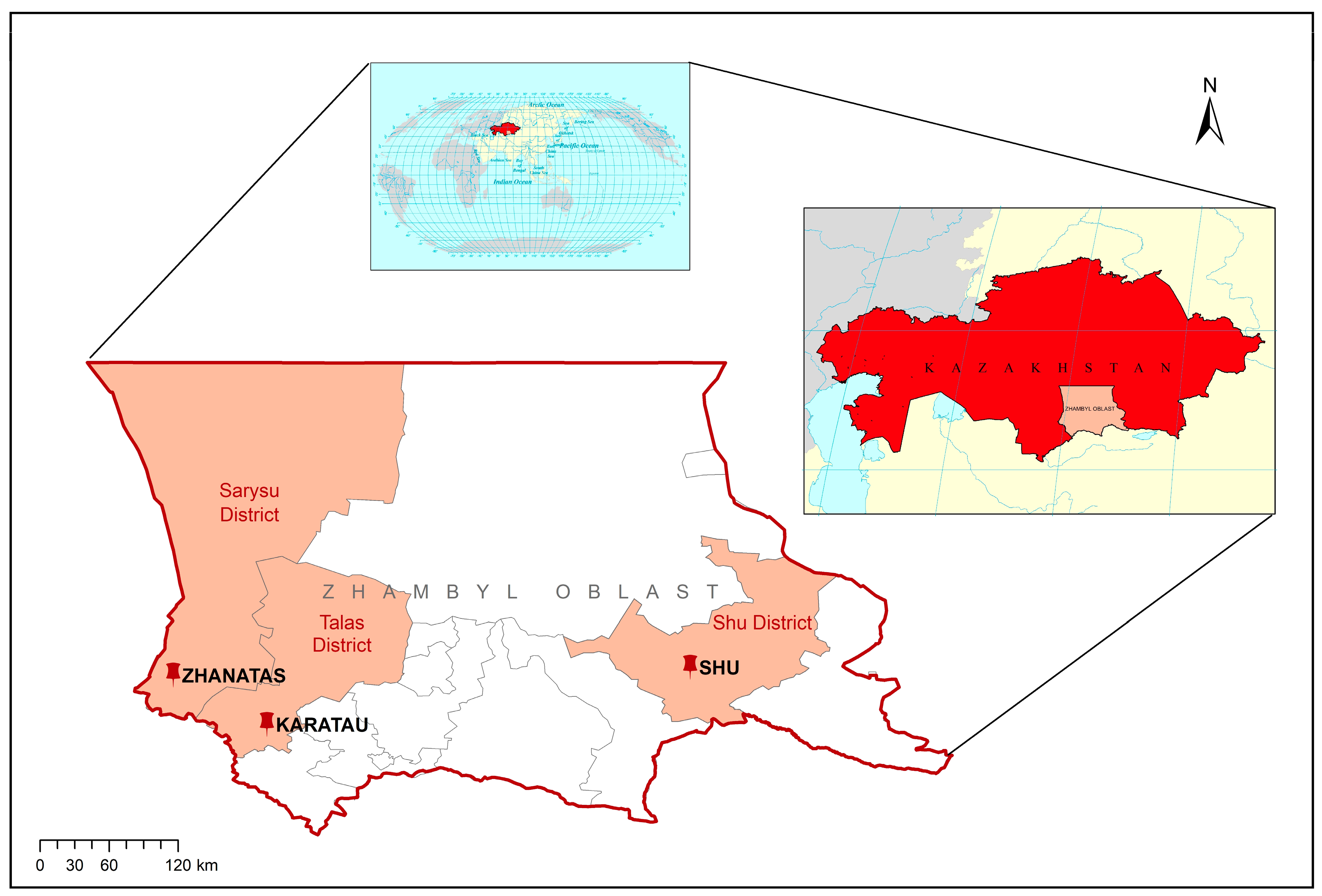

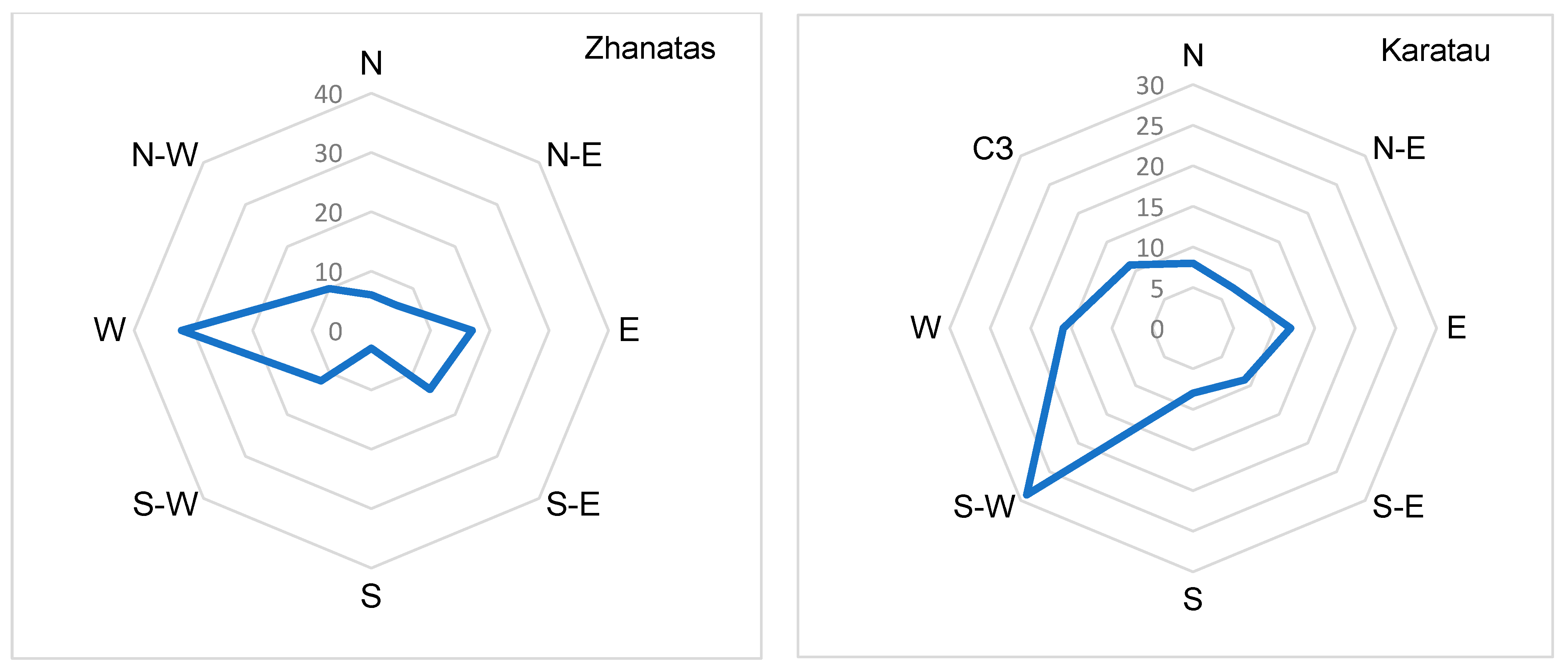
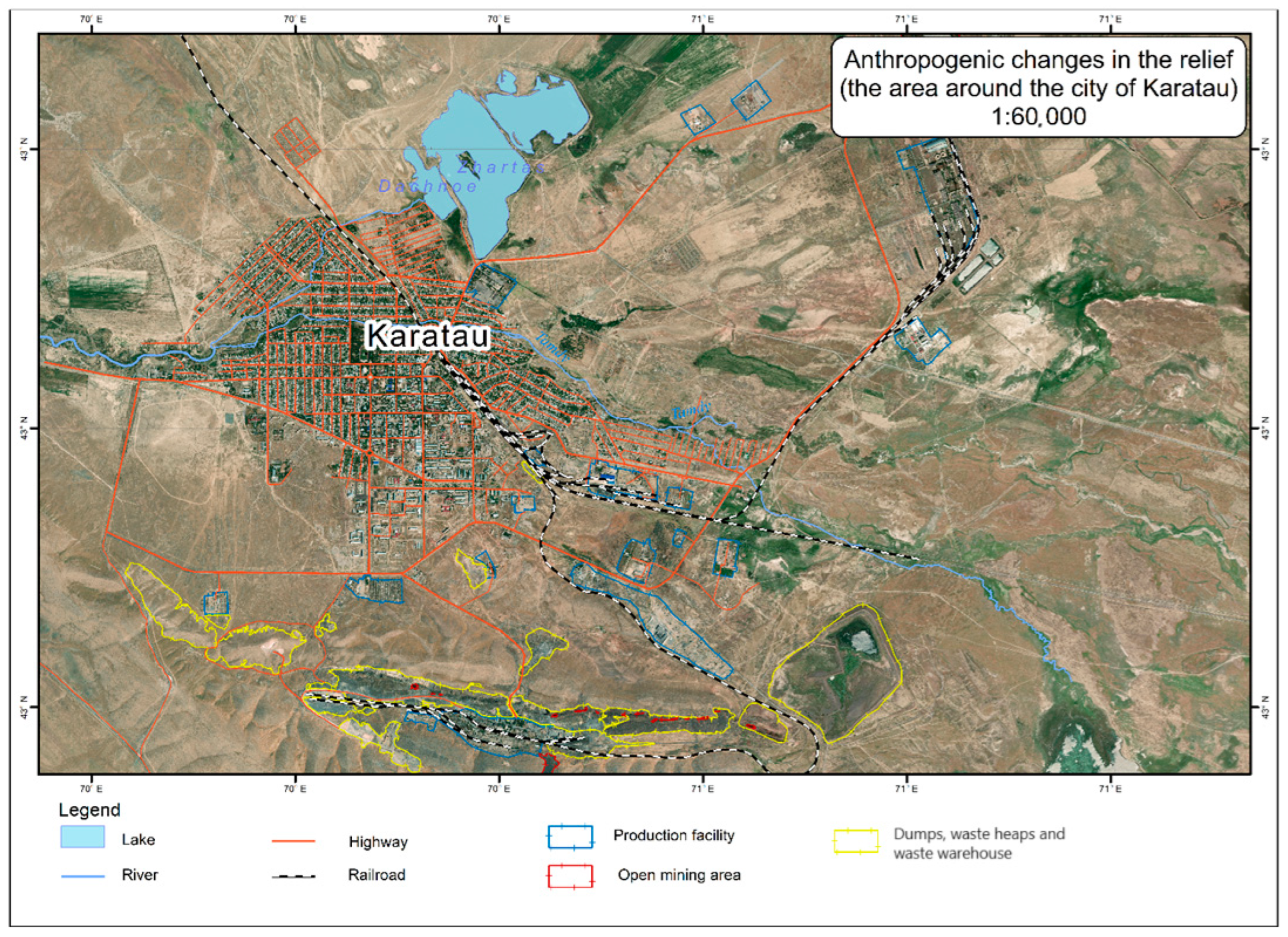

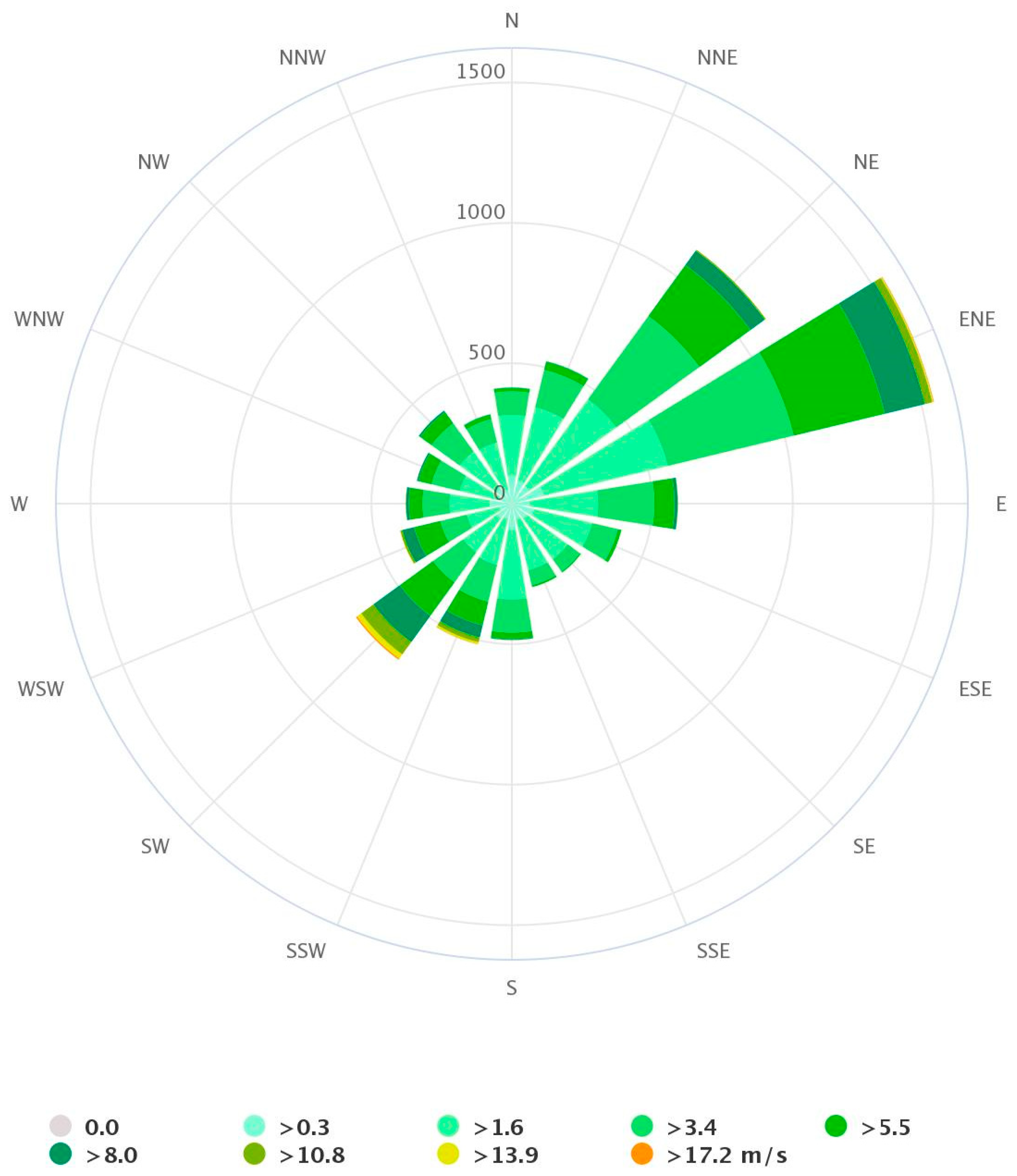
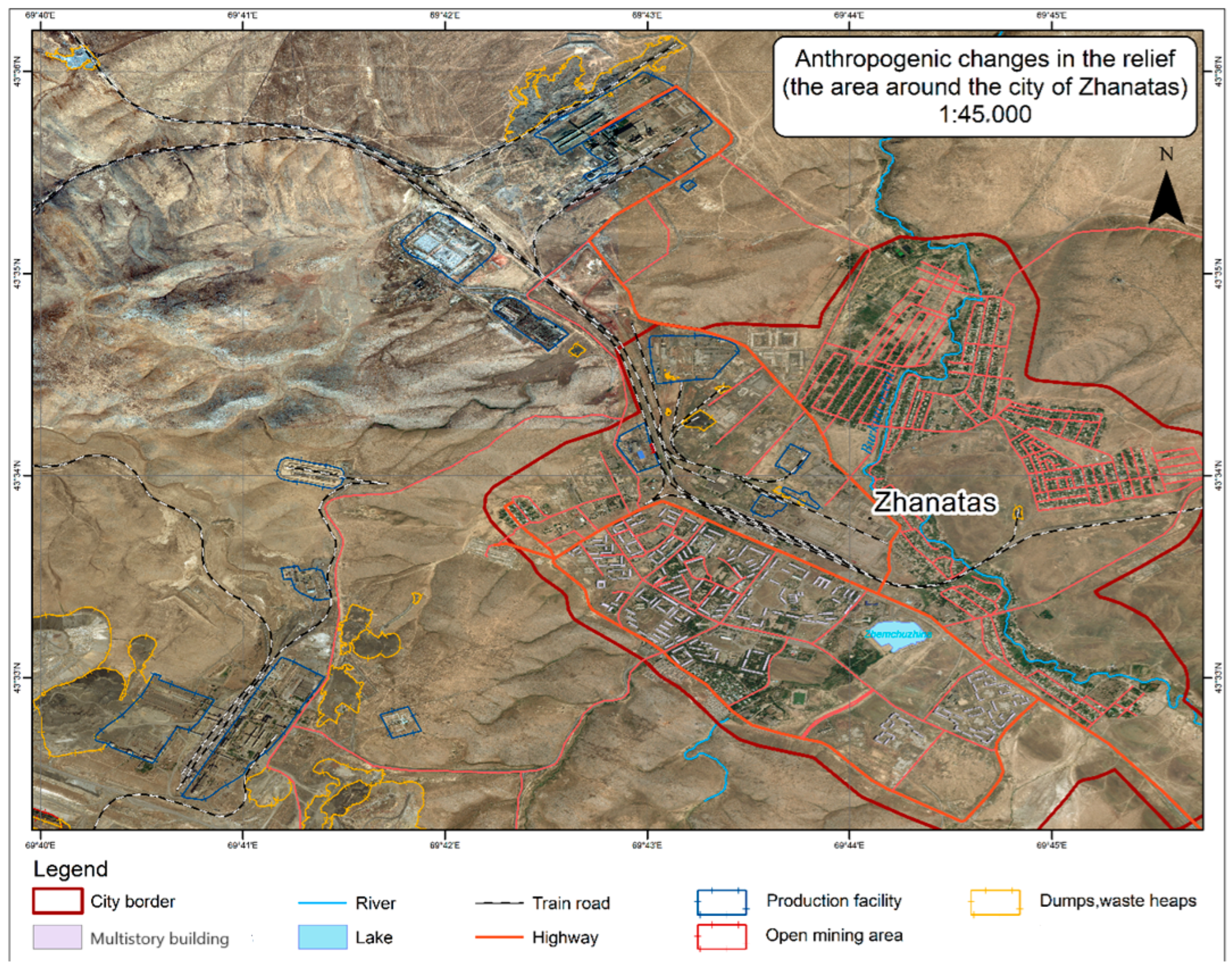
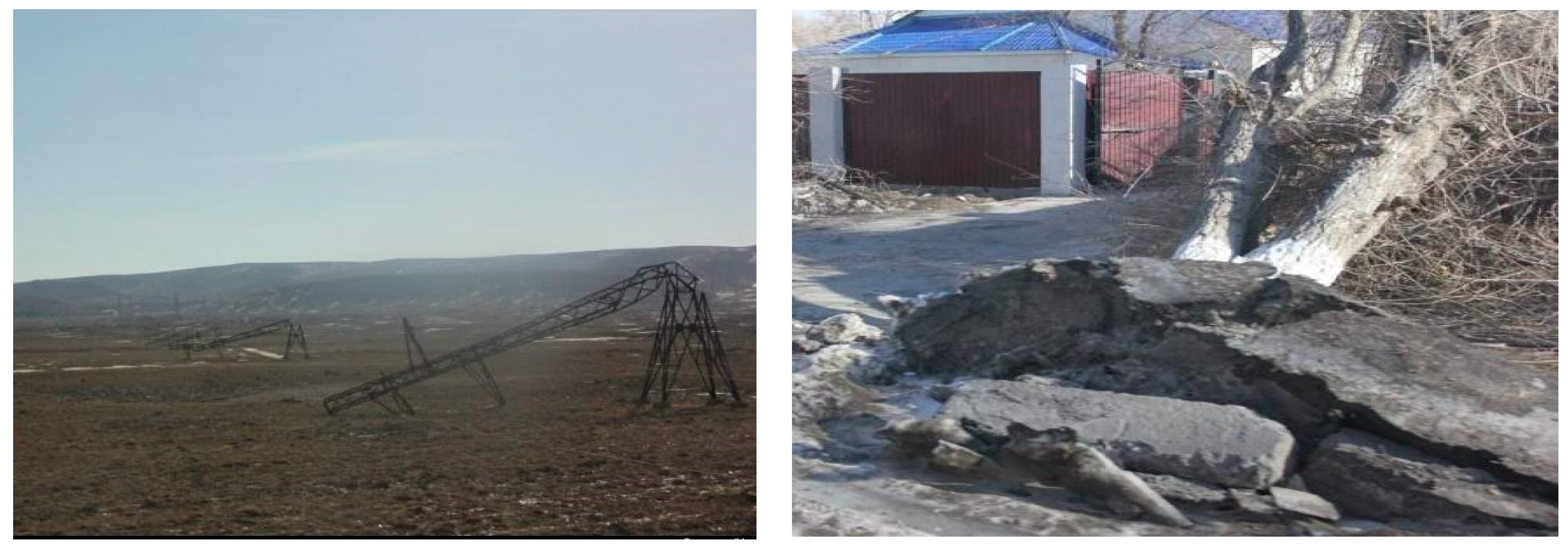
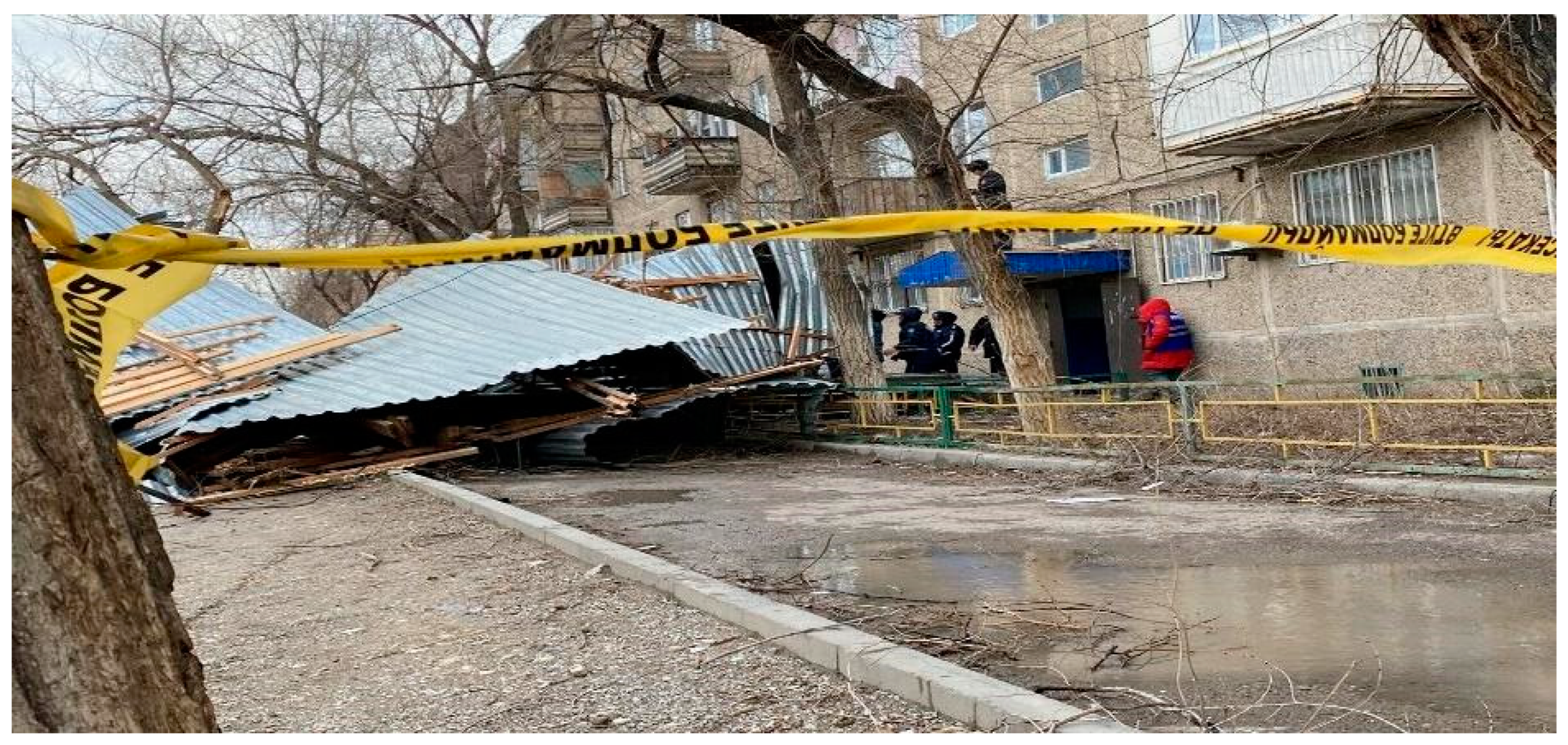
| Station | Relative Humidity, Number of Days | Precipitation, mm | |||
|---|---|---|---|---|---|
| Less than 30% | Less than 80% | Annual Quantity | Daily Maximum | Date | |
| Zhanatas | 174 | 80 | 332.9 | 20.2 | 26 March |
| Karatau | 169 | 47 | 233.9 | 25.8 | 17 January |
| Station | Average Temperature °C | abs. max °C | abs. min. °C | Last Frosts | First Frosts | Number of Days without Thaws | Number of Frosty Days |
|---|---|---|---|---|---|---|---|
| Zhanatas | 12.0 | 42.0 | −31.8 | 30 March | 1 October | 34 | 103 |
| Karatau | 13.0 | 41.2 | −35.3 | 30 March | 2 October | 26 | 98 |
| Station | Wind Speed, m/s | Number of Cases by Gradations of Speed | |||||||||||
|---|---|---|---|---|---|---|---|---|---|---|---|---|---|
| Average | Max | 0–1 | 2–3 | 4–5 | 6–7 | 8–9 | 10–11 | 12–13 | 14–15 | 16–17 | 18–20 | 20< | |
| Zhanatas | 2.5 | 30 | 16,031 | 10,926 | 6081 | 2654 | 1070 | 792 | 196 | 162 | 45 | 27 | 8 |
| Karatau | 1.3 | 27 | 24,650 | 8599 | 2706 | 1087 | 372 | 188 | 122 | 85 | 46 | 24 | 5 |
| Measuring Point Location | Time | Wind Direction and Speed | Air Temperature | Atmosphere Pressure | |
|---|---|---|---|---|---|
| Karatau | North-west (2.2 km from the city) 43.14575 N. 70.43071 E. | 29 November 2023 13:15 p.m. | Wind direction: from south to north, average speed 16.6 m/s | 19.3 °C | 96 Pa |
| Southern part of the city (near abandoned multi-story buildings) 43.16445 N. 70.48087 E. | 29 November 2023 12:45 p.m. | Wind direction: from south to north, average speed 12.5 m/s | 18.9 °C | 95.7 Pa | |
| Zhanatas | South-west of the city (3 km from the city—location of waste heaps) 43.52389 N. 69.69833 E. | 29 November 2023 16:10 p.m. | Wind direction: from southwest to northeast, average speed 8.9 m/s | 9.8 °C | 94.8 Pa |
| City center 43.55679 N. 69.72476 E. | 29 November 2023 15:40 p.m. | Wind direction: from southwest to northeast, average speed 7.9 m/s | 9.2 °C | 94.5 Pa |
| Station | N | N-E | E | S-E | S | S-W | W | N-W | ||||||||
|---|---|---|---|---|---|---|---|---|---|---|---|---|---|---|---|---|
| * F | ** S | F | S | F | S | F | S | F | S | F | S | F | S | F | S | |
| Zhanatas | 6 | 2.4 | 6 | 2.2 | 17 | 2.5 | 14 | 3.1 | 3 | 2.6 | 12 | 4.3 | 32 | 4.2 | 10 | 2.7 |
| Karatau | 8 | 2.2 | 7 | 1.8 | 12 | 1.7 | 9 | 1.7 | 8 | 2.2 | 29 | 3.6 | 16 | 2.5 | 11 | 2.0 |
| Dangerous Phenomenon | Date | Aftermath | |
|---|---|---|---|
| Zhanatas | Strong wind (gusts up to 30 m/s) | 23 January 2021 | Power line breaks: 747 subscribers were left without power supply |
| Strong wind (gusts up to 30 m/s) | 3 January 2023 | Emergency shutdown of electrical networks, central boiler room, cellular and telephone communications; 3500 subscribers were left without power supply | |
| Strong wind (gusts up to 26 m/s) | 11 February 2023 | Emergency shutdown of electrical networks: 2014 subscribers were left without power supply | |
| Karatau | Strong wind (gusts up to 30 m/s) | 3 January 2023 | Emergency shutdown of electrical networks, partial breakdown of the metal roofs of eight multi-story buildings, including the administrative building of the city and the railway station; 3284 subscribers were left without power supply |
| Strong wind (gusts up to 24 m/s) | 11 February 2023 | Emergency shutdown of electrical networks: 1785 subscribers were left without electricity supply; 3285 subscribers left without cold water supply; the roofs of five multi–story buildings were torn down |
| Activity | Comfortable Wind Speed Ranges (m/s) |
|---|---|
| Sitting | 0–2.6 |
| Standing | 0–3.9 |
| Walking | 0–5.4 |
| Uncomfortable for any activity | >5.4 |
Disclaimer/Publisher’s Note: The statements, opinions and data contained in all publications are solely those of the individual author(s) and contributor(s) and not of MDPI and/or the editor(s). MDPI and/or the editor(s) disclaim responsibility for any injury to people or property resulting from any ideas, methods, instructions or products referred to in the content. |
© 2024 by the authors. Licensee MDPI, Basel, Switzerland. This article is an open access article distributed under the terms and conditions of the Creative Commons Attribution (CC BY) license (https://creativecommons.org/licenses/by/4.0/).
Share and Cite
Kaimuldinova, K.; Aliaskarov, D.; Laiskhanov, S.; Wendt, J.A.; Muzdybayeva, K. Exposure to Wind as a Threat to the Sustainable Development of Small Towns in the Zhambyl Region (Kazakhstan). Sustainability 2024, 16, 2144. https://doi.org/10.3390/su16052144
Kaimuldinova K, Aliaskarov D, Laiskhanov S, Wendt JA, Muzdybayeva K. Exposure to Wind as a Threat to the Sustainable Development of Small Towns in the Zhambyl Region (Kazakhstan). Sustainability. 2024; 16(5):2144. https://doi.org/10.3390/su16052144
Chicago/Turabian StyleKaimuldinova, Kulyash, Duman Aliaskarov, Shakhislam Laiskhanov, Jan A. Wendt, and Karlygash Muzdybayeva. 2024. "Exposure to Wind as a Threat to the Sustainable Development of Small Towns in the Zhambyl Region (Kazakhstan)" Sustainability 16, no. 5: 2144. https://doi.org/10.3390/su16052144






